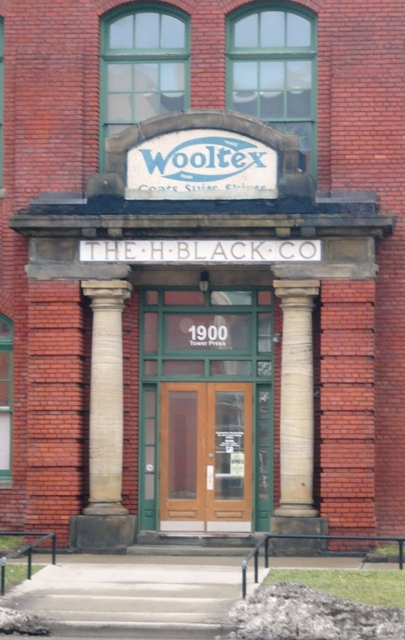Tower Press

Upon entering the Tower Press building from Superior Avenue, one can not help but notice "The H. Black Co." engraved in tile over its doors. The Black family, enterprising Hungarian Jewish immigrants, decided to produce ready-to-wear clothing based on European patterns. The business began in their own home, and by 1883 Herman Black founded the H. Black Company as a manufacturer of women's coats and suits.
Morris Black, Herman's son born in 1868, became a designer in his father's company in 1890 after graduating from Harvard University. In 1903, Morris succeeded his father as president of the H. Black Co. He would go on to become responsible for turning Cleveland into a national leader in the garment industry, second only to New York in importance. In 1907, Morris moved the H. Black Co. from its original location in the Warehouse District to a state-of-the-art facility on Superior Avenue - what is now known as the Tower Press Building.
Morris Black believed that factories should be productive as well as pleasant workplaces for his employees. Black and architect Robert Kohn built a factory that provided attractive surroundings, proper ventilation, and ample lighting for his workers. The building consists of a two-story central wing connected by two three-story wings forming a "U" shape. In the rear of the building is a tower, square at the base and rising to become an octagon. When the Tower Press building was constructed, the surrounding area was mostly frame houses or undeveloped land. By the 1930s, however, the area became an emerging garment district, home to notable garment companies such as Bobbie Brooks, Inc., Joseph & Feiss Co., Cleveland Worsted Mill, Richman Brothers Co., and Printz-Biederman.
Morris Black served as president of the H. Black Co. until 1922, when the company merged with the Printz-Biederman Co. Printz-Biederman was founded in 1893 by Moritz Printz, master tailor and head designer of the H. Black Co. Black, however, continued to have an impact on the garment industry as head of the Cleveland Garment Manufacturer's Association, where he attempted to stabilize the garment industry by making agreements with labor unions, allowing for the impartial arbitration of workers' grievances during strikes.
On June 6, 1911, the International Ladies' Garment Workers' Union (ILGWU) staged a massive strike. Four thousand of Cleveland's garment workers took to the streets to protest unfair working conditions. Workers demanded a 50-hour work week with Saturday afternoons and Sundays off, but employers rejected their demands. The often violent strike lasted four months but ultimately failed as manufacturers were still able to fill their orders using smaller, non-union shops. Though the ILGWU eventually gained recognition and conditions gradually improved, the decline of Cleveland's garment industry, which began during the Great Depression and climaxed in the late 1960s and early 1970s, led to the loss of most of these jobs.
In 1928 the H. Black Building was renamed the Evangelical Building, becoming home to a publisher of religious materials. It housed a variety of tenants in the succeeding years, but by 1987 the building was vacant and remained so until 2002. Since then, the building has been remodeled, providing 8,000 square feet of retail and office space on the ground level as well as apartments on the upper levels. The 130-foot-tall tower has been turned into five floors of living space. It takes a climb of over 100 steps to reach its top.
Images









